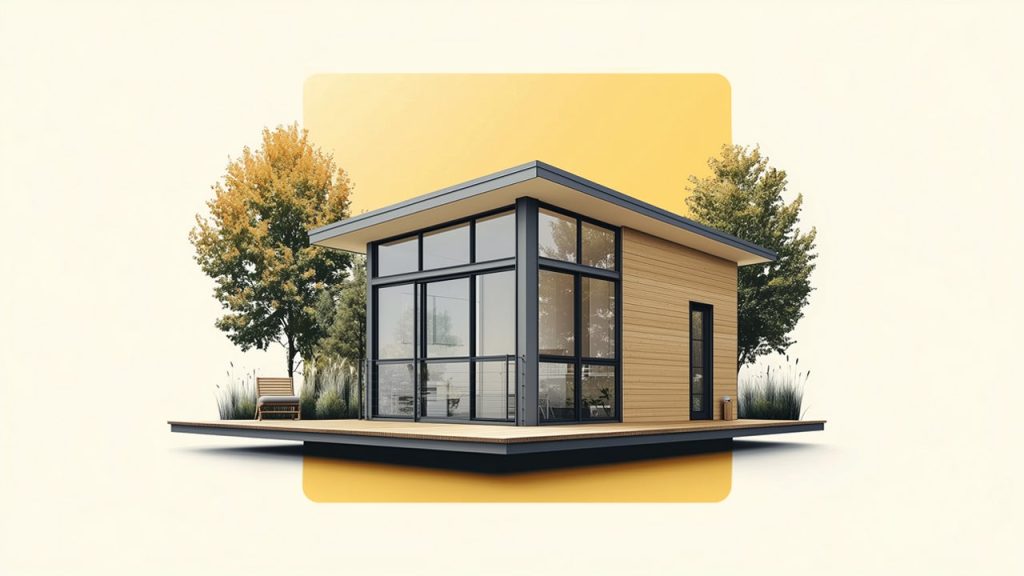Key takeaways
- Tiny homes are often not eligible for mortgage loans but are eligible for other financing options, like personal and home equity loans.
- Manufacturers or builders may offer in-house financing options that could offer better rates than lenders or banks.
- Depending on the details of your tiny home, it may not be eligible for other financing options.
As the cost of housing in America continues to skyrocket, downsizing to a micro-living space has become an increasingly popular trend. While tiny homes might have more appeal than traditional homes in terms of affordability, these homes still have their own set of challenges.
If you’re thinking about making a major lifestyle switch from a large home to a tiny home, you’ll need to know which types of financing can be used as tiny house loans, as well as the requirements for approval.
What is a tiny home?
While there is no official definition of a tiny home, tiny living enthusiasts generally recognize freestanding small living spaces to be tiny houses. However, the International Residential Code classifies tiny homes as “400 square feet or less, excluding lofts.”
Tiny homes tend to offer the same amenities as full-sized homes: a bedroom or two, a kitchen, dining area, living space, bathroom and some kind of storage. Many tiny homes offer a patio or outdoor living space, as well.
For many, tiny living helps owners keep debt to a minimum or avoid the burden of a traditional mortgage. Common types of tiny homes include:
- Tiny homes on wheels
- Tiny homes on foundations
- Small motor homes and vans
- Shipping containers
- In-law apartments and carriage houses
Average cost of a tiny house
Part of the appeal is that the cost of tiny homes is often much less than a traditional home. The median sales price of an existing home in September 2024 was $404,500. A tiny house, by comparison, can cost as little as $20,000 and as much as $180,000.
The price you pay for a tiny home depends on its size, the materials and upgrades and whether the labor is done yourself or by professionals. Building a tiny house gives you much more control over the final price tag, depending on the choices you make. Still, that price difference comes from sacrificing a lot of the conveniences of larger homes.
Tiny homes are typically under 600 square feet, but the average size is a mere 225 square feet. The average size of a new single-family home sold in 2023, on the other hand, was 2,286 square feet. And when measured by square foot expense, tiny homes can actually be more costly at about $150 to $450 per square foot. By contrast, single-family homes were $224 per square foot on average in November 2024, according to data from the Federal Reserve Bank of St. Louis.
Tiny home financing options
Because the purchase price for tiny houses is significantly less than a single-family home, traditional home loans might not always be the best option for financing. Luckily, there are other types of financing available.
Personal loans for tiny homes
Personal loans are the most flexible tiny house loans available, as they can be used for nearly anything and can be taken out in just about any amount between $1,000 and $100,000. They are generally unsecured loans, too, which means you won’t immediately lose your dwelling if you are unable to make payments on the loan.
Some lenders offer personal loans specifically designed for tiny home purchases. LightStream, for instance, offers fixed-rate tiny home financing starting at 8.99 percent for its personal loans when you sign up for autopay.
To obtain the most favorable rates on a personal loan, however, you’ll need a good credit score. The average personal loan interest rate is over 12 percent and the rate you get may be higher, depending on your credit profile. If your credit history has a few blemishes, you may be better off choosing a secured loan with a lower interest rate.
Home equity loans
If you already own a home and have built up equity, certain types of tiny home financing can be done through a home equity loan. As a prerequisite, you’ll need to have enough equity in your home to borrow against. Lenders often enforce minimum loan amounts, so using your equity to relocate to a low-budget micro-dwelling might not be the best use of a home equity loan.
If you’re adding a tiny home to the property as a guest house or in-law suite, however, home equity loans may be a good financing option for you. Adding a tiny home to your property will likely add value to your home’s sale price, so you could recoup your investment if you decide to sell your house.
Home equity line of credit
Home equity lines of credit (HELOCs) are similar to home equity loans. Both are secured against your home and are funded by the equity in the property. The difference between a HELOC and a home equity loan is that a HELOC works like a credit card, allowing you access to a line of credit with a set limit that you can withdraw funds from as needed.
HELOCs are an ideal option for DIY tiny home financing because you can withdraw small amounts to fund each step of the build, taking only what you need when you need it. This reduces the amount you need to pay back and will help keep your interest payments to a minimum. A HELOC is a secured loan against your home, so if you don’t pay it back, you risk losing your home.
Mortgage loans
In most cases, tiny homes won’t qualify for mortgage loans. If the blueprints meet all your bank’s requirements for a home mortgage, it could be a tiny house financing option. In general, a home needs to sit on a foundation and have a minimum square footage to qualify, but it’s still worth a phone call to your bank to ask.
RV loans
Anyone who’s traveled in an RV knows that they’re basically tiny homes on wheels. In fact, some mobile tiny homes may meet all the standards to be classified as an RV, which would qualify them for an RV loan. The main issue with that, though, is that you generally can’t get an RV loan if it’s intended to be your primary dwelling. If you’re financing a tiny house to live in part-time, however, this could be the loan for you.
Manufacturer or builder financing
Some tiny house builders offer financing as part of their overall package. The loan terms and rates are often similar to those of other types of loans. However, every manufacturer or builder will have different terms and eligibility requirements.
Before applying, compare multiple options and make sure you meet the minimum credit requirements. If you can find a tiny home builder that offers this kind of financing, it may be easier to get the money you need for your home. Compare financing options from the best lenders to make sure you’re getting the most competitive rate.
Pros and cons of tiny home living
Making a major life change, like moving into a tiny home, requires looking at both the potential advantages and disadvantages. While tiny home living can be a more exciting and frugal way to live, there are downsides to consider as well.
Pros
- Can be far more affordable than a traditional mortgage
- Typically saves money on utilities
- Simplified living: more mobility and flexibility
- Less room means less space for clutter
Cons
- Limited storage, making decluttering a challenge
- May be subject to zoning laws
- Tricky financing
- Usually a higher depreciation than a traditional house
What to know before financing a tiny home
There are several options available for financing a tiny home, from borrowing a personal loan or traditional mortgage if it meets the requirements to financing an RV loan if your home is on wheels. It’s critical to do your research before investing to see what kind of financing your new home will be eligible for.
If your tiny house is on wheels or built using a trailer, it may not qualify for a traditional mortgage. Inquire with your builder to see what kind of financing options may be available to you.
Before financing a tiny home, understand that it may not appreciate at the same rate a traditional piece of real estate might. Some tiny homes depreciate quickly, similar to a car or truck, so you are not guaranteed a return on your investment.
You may also need to finance real estate to park your tiny home on, depending on the zoning laws in your area. Land for your house will likely be an additional expense you need to factor in.
Tiny home considerations
Tiny homes may be a good fit for some homeowners, but there are some unique considerations to take into account before buying one.
- Depreciation vs. appreciation. Most homes appreciate over time, but this hasn’t been the case with tiny homes. Your tiny house could depreciate in value, similar to how a car depreciates or an RV. That means your tiny home could sell for less than what you owe if you decide to move, leaving you responsible for the remainder of the loan.
- Zoning laws. Carefully look into local zoning laws, including square footage limitations, construction codes and any permits you might need to apply for prior to starting your build. These can all add a considerable cost to your project and should be considered into the total cost before financing a tiny house.
Bottom line
If the minimalist lifestyle is calling your name, there are many different tiny home financing options at your disposal. A personal loan or financing directly from the builder can be your best bet, but you should always explore your options. Spend plenty of time reviewing the numbers before you decide whether a tiny home is right for you.
Tiny home financing frequently asked questions
Read the full article here









